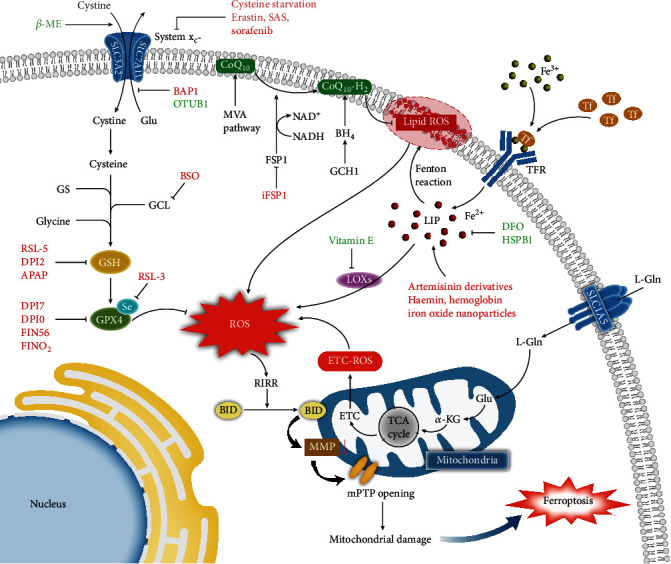Figure 1.

Increasing ROS triggers mitochondrial damage related to ferroptosis under cysteine starvation. The pathways correlated with reactive oxygen species (ROS) accumulation are as follows. (1) Cystine turns into cysteine after entering the cytoplasm by system xC−; the latter involves glutathione (GSH) biosynthesis with the catalysis of γ-glutamylcysteine ligase (GCL), glutathione synthetase (GS), and glycine; and GSH as a cofactor further facilitates the scavenging of ROS by glutathione peroxidase 4 (GPX4). (2) Ferric irons transferred by transferrin (Tf) become ferrous irons after entering the cytoplasm by the transferrin receptor (TFR); the ferrous irons enrich the labile iron pool (LIP), which facilitates the generation of ROS via the Fenton reaction and enzymatic reaction (e.g., LOXs). (3) L-Glutamine (L-Gln) becomes ketoglutaric acid (α-KG) via glutaminolysis after entering the cytoplasm by solute carrier family 1 member 5 (SLC1A5), and α-KG supplies a carbon source for the tricarboxylic acid (TCA) cycle, which activates the electron transfer chain (ETC) to generate ETC-ROS. (4) The coenzyme Q10 (ubiquinone/CoQ10) derived from the mevalonate pathway (MVA pathway) and its reduced form ubiquinol (CoQ10-H2) generated via the NADH-FSP1-CoQ10 pathway and the GCH1-BH4-phospholipid axis participate in the scavenging on lipid ROS. The increase in ROS triggers ROS-induced ROS release (RIRR), which promotes proapoptotic protein BID translocation into the mitochondria. Then, the collapse of mitochondrial membrane potential (MMP) and the sustained opening of the mitochondrial permeability transition pore (mPTP) cause mitochondrial damage, inducing ferroptosis. Inducers of ferroptosis are in red; inhibitors of ferroptosis are in green. Relevant abbreviations: NADH: nicotinamide adenine dinucleotide; FSP1: ferroptosis suppressor protein 1; GCH1: GTP cyclohydrolase-1; BH4: tetrahydrobiopterin.
